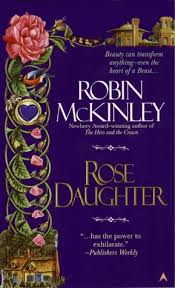I read Robin McKinley’s Beauty years ago purely for pleasure. A retelling of Beauty and the Beast, it was a perfect red wine and hot soak read. It seems one retelling of the classic fairytale was not enough for McKinley and almost twenty years later (in 1996), she published Rose Daughter. While I enjoyed Beauty, I loved Rose Daughter. With all the fantastic fairytale symbolism and devices, such as the animal guide and the names of characters (the three sisters Lionheart, Jeweltongue and Beauty), this retelling was clearly written with feminism in mind as Beauty is a strong, stubborn, at times flawed, young woman. There are no heroes in this book, only heroines and in the end it is her (and her sisters) who save herself, her father and even the Beast.
Beauty actively questions her role in the story, “Is that all that matters?…This is a story like any nursery tale of magic? Where any maiden will do, any- any- monster, any hero, so long as they meet the right mysterious old woman and discover the right enchanted doors during the right haunted midnights…” (192). The thought initially shakes her; however, she proves her courage declaring “Well, I cannot know that, can I? I can only do what I can do-what I can guess to try-because I am the one who is here. I am the one who is here. Perhaps it will make a good nursery tale someday” (192).
While there is romance, there are not that many scenes where Beauty and Beast are in the same place together; instead, the focus is on Beauty and her relationships with her sisters and the roses. Like the flowers in her garden, Beauty grows and becomes more than just her namesake.
It’s a beautiful little story and one of the best Beauty and The Beast retellings I’ve ever read.

